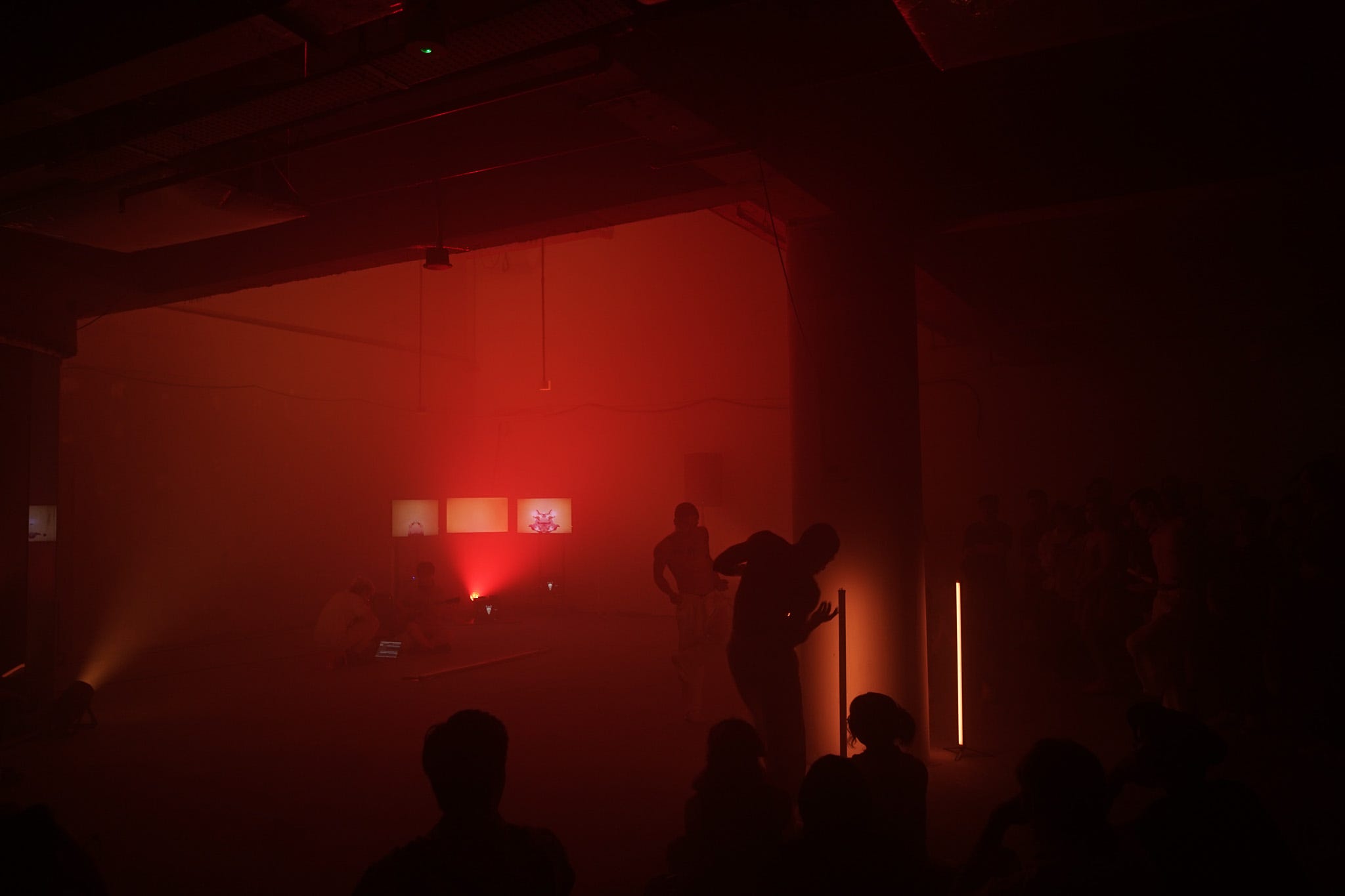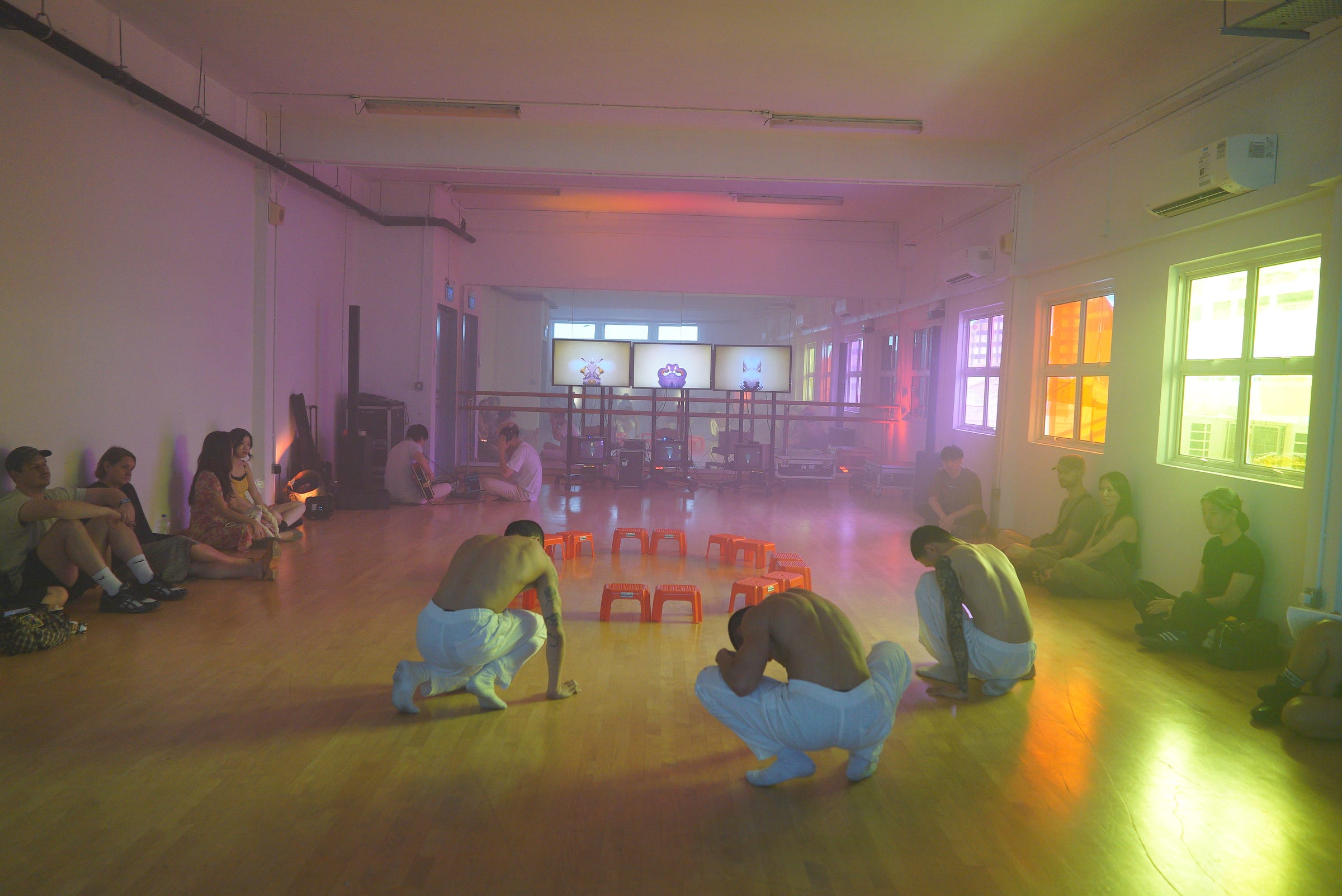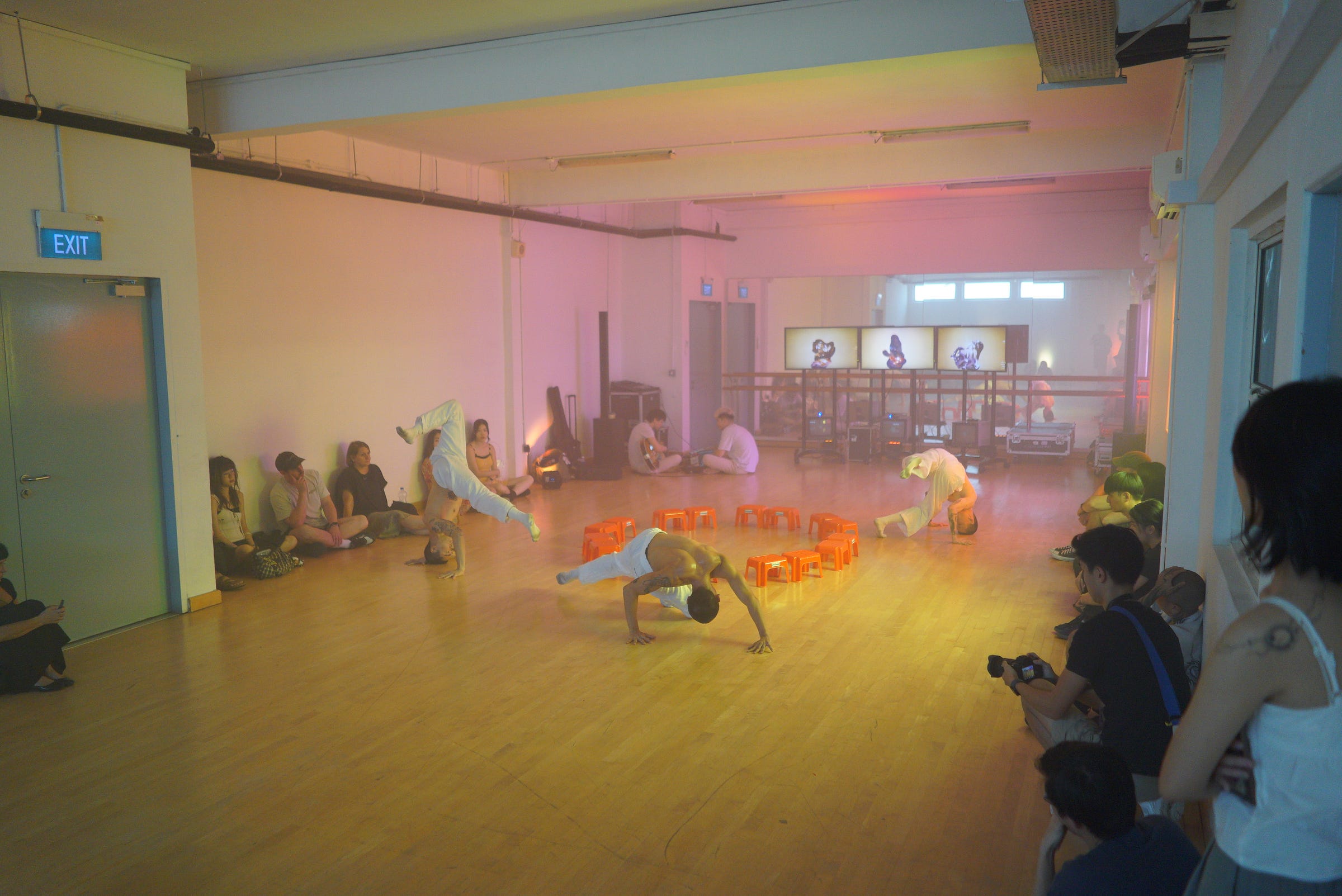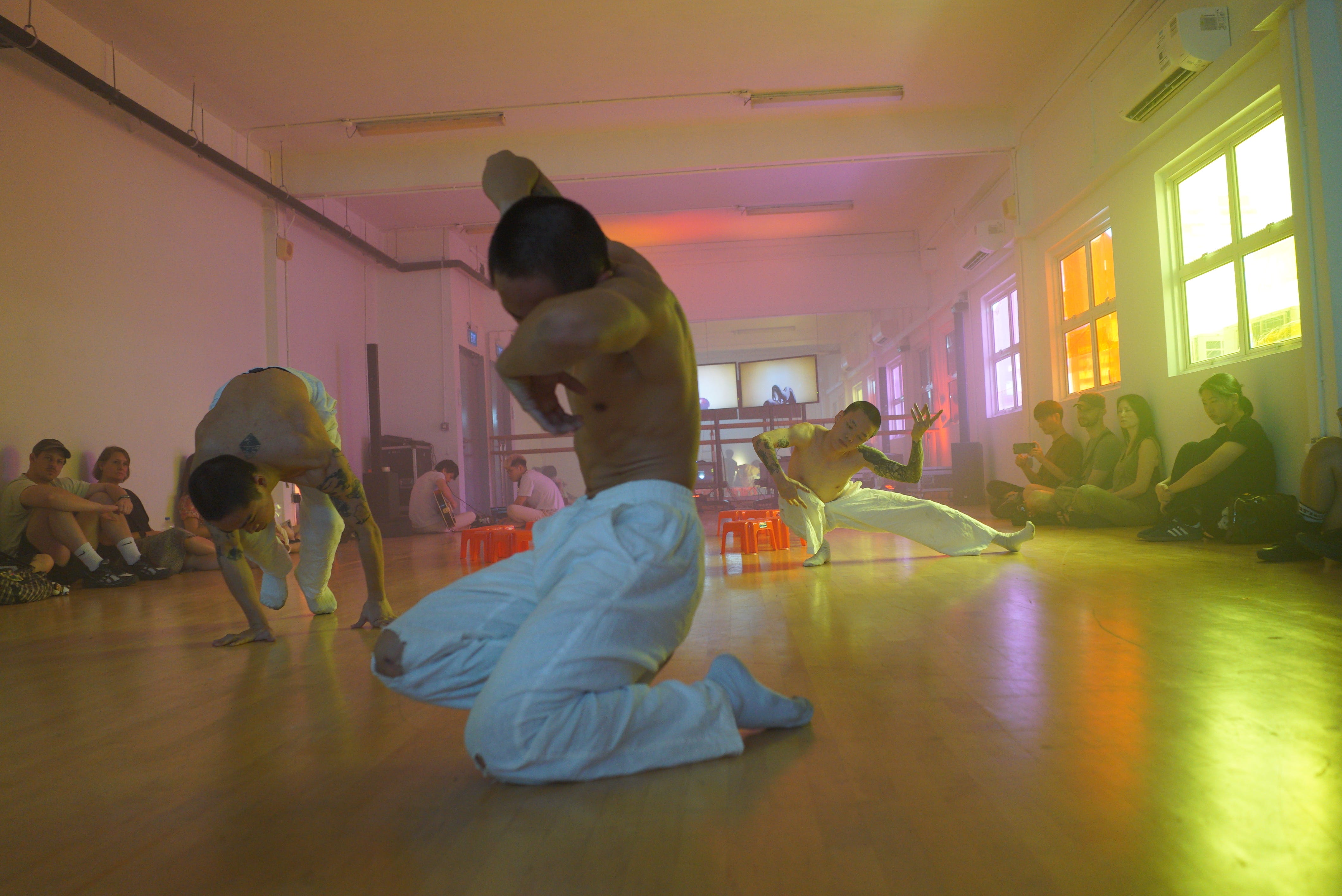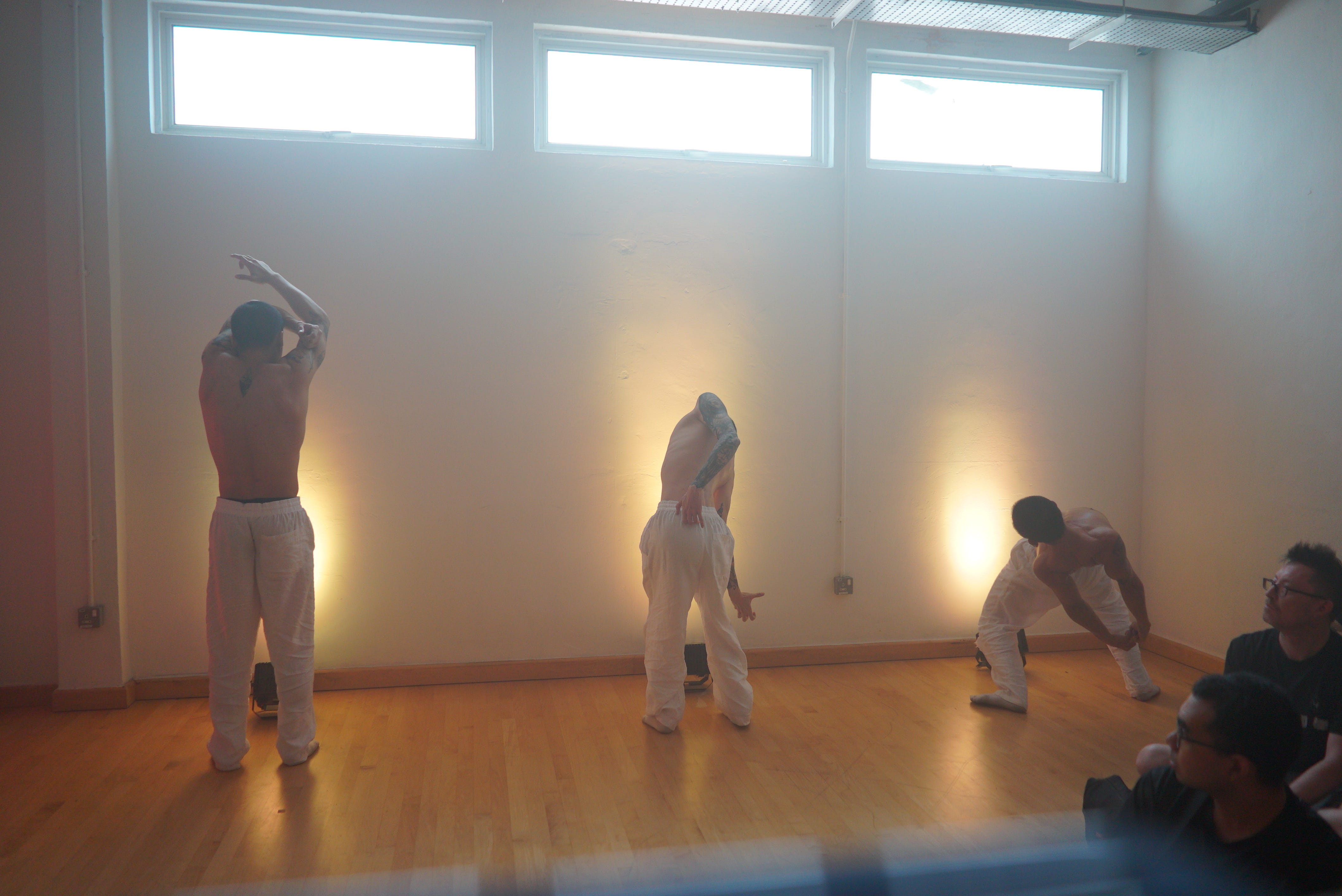Crawling Under Tiger is an experimental performance activation whose movements are dreamt up by Singaporean movement practitioner and choreographer Loy that takes place as a type of cyber ritual where the dancer’s body becomes a vessel for technological entities. It takes its name from Hu Ye (虎爷), a tiger god in Taoism. Sometimes, the Hu Ye sculpture is contained within a cave, requiring devotees to stoop or lower their bodies in order to pray to the god.
Drawing from the shared childhood experiences of music producer Mary Sue and movement practitioner Loy, of traditional myths rituals and folklores, a birthday bash of three deities is re-imagined through a sino-futurist lens in this transdisciplinary performance in collaboration with Hothouse.
Description of the work, Crawling Under Tiger. Source: *SCAPE / Hothouse


The piece draws inspiration from Loy’s Teochew upbringing and that of his musical collaborator, producer Mary Sue, who composed the music for the work with the intention to "put the dancers into a trance.1" Despite its ritualistic quality, the work is adamantly “not religious2” but rather a constructed narrative that draws upon occult traditions — a collage of research informed by Taoism and other forms of deity worship in Asia, as well as the shared experiences of both collaborators that draws upon their childhood, religion and ancestry. As a live activation, the piece unfolds as a lived experience that is traced rather than “performed. This way of choreographing embraces dance as something that is unstable and evolving.
Loy’s bio notes that his body of work deals with the worship of false idols, which is an intriguing liner and suggests that his practice may be critical of the human tendency to follow personal beliefs and superstitions as truths. Perhaps in subversion of that, he creates experimental choreographies that blend fact and fiction. I feel a deep connection to the source material for this piece and Loy’s occult research, as my father is a Tangki (Taoist medium).
Due to overlapping performance schedules at *SCAPE during comma Arts Festival, Loy and I were unable to attend each other’s performances and I could not view the work in its most fully realised form. Restaged as part of Aliwal Urban Arts Festival, the version of Crawling Under Tiger that I experienced was one which Loy described as the most ”indulgent” of the three stagings. From what I have seen of the *SCAPE documentation, the first two versions were more atmospheric, performed in an industrial setting, bathed in fog and red light. The dancers were also able to weave between pillars and move freely around the space. At Aliwal however, the performance was held in a dance studio and had less production support as compared to the earlier versions. I was curious as to how Loy and his collaborators would negotiate this subsequent staging in a new space.
Instead of trying to recreate the work that had occurred at *SCAPE, Loy seized the opportunity to explore a new arc for the work, incorporating fresh elements and even changing the music to something softer, more atmospheric and ethereal than in the earlier version. The piece also followed a more linear progression and made full use of the space’s longtitude. In going from point A to B, the dancers felt like they had a clear pathway, instead of being caught in the looping tendencies of moving through “liminal space.” The setup reminded me of an obstacle course, as the dancers navigated through a series of transformative and acrobatic feats.
The studio was brightly lit, leaving all elements exposed, it was also narrower and more rectangular than the space at *SCAPE. At the end of the room, three screens were placed side by side on stands to create an altar-like structure. In front of it was a circular configuration of 8 pairs of small red plastic stools, followed by a grey stepladder. The dancers, topless and wearing white pants, entered the space and knelt or sat near the screens. When the music began, a transformation unfolded. The movement started with slight bodily tremors, often associated with spirit possession, before turning into something otherworldly as the bodies became animated by unseen forces. At one point, to further underscore the connection between the bodies and virtual entities, the dancers moved to stand in front of their corresponding deities.
One undeniable aspect of the performance was the strong presence of male physicality. Three shirtless male dancers, traveling together as a pack pushing forward through the space, carried a strong collective energy. This made me reflect on how deities across cultures often favoured, guided, or formed close relationships with young men—whether as disciples, lovers, or chosen mediums.
Somewhere in my memory, I recall Loy describing his choreographic style as "sludgy" or "stream-of-consciousness." This is funny because Loy himself is neither a "sludgy" mover nor person. This candid description reflects an approach that sets itself up to challenge conventional dance standards. However, this does not mean rigor is ignored—Loy remains deeply invested in the craft of dance while exploring how it can move beyond athleticism. How to retain the physical integrity of dance while keeping it experimental3?

For a segment of the work, inspired by the Taoist Lo Shu 洛书 Square, Loy developed a method of numbering points on the body and had himself and the other dancers perform five sets of 15 movements based on this system. I wonder if revealing such mechanisms or technique risks demystifying the performance too much. However, as someone who is deeply drawn to esoteric systems and made-up logics, this aspect of the choreography is interesting to me, also because of its generative nature. While it may not be crucial to our viewing or enjoyment of the piece, it is a smart and effective system for creating new movement patterns. In Taoism and many other religious traditions, numbers also hold great significance as codes for cosmic order and mystical symbolism. Taoist rituals use numbers to determine altar arrangements, talismanic inscriptions, and geomantic calculations (Feng Shui). In the 21st century, interest in divine numbers has also surged, from numerology to angel numbers. Encoding choreography with occult numerical systems not only embeds a new logic into movement but also infuses the performance with invisible potencies.
Loy’s choreography is also one that allows for individual autonomy and expression within countless permutations. All three dancers came from different backgrounds, Jack and Leo are both street dancers and have distinct kinesthetics to how they move. Jack, for instance is someone who carries a lot of nuance with him when he dances and I laughingly shared with Loy that “I feel as if he is choreographing underneath your choreography!” While this was a dance piece, not an actual trance ritual, it was the dancing itself that took on the role of spirit. At some points in the performance I caught glimpses of divine archetypes through the shapes the dancers had created with their bodies. Loy has also stated that he had no desire to “perform” the work, hence rejecting notions of performance as something rehearsed for an audience’s consumption. Instead, it implies a preference for embodiment over display, where movement arises organically from internal systems and states rather than being deliberately “performed” as a spectacle, an approach that I would claim to be quite “Butoh”.
At one point, each dancer climbed slowly over the ladder—a complicated ascent I interpreted as a type of significant “crossing”. I joked to Loy afterward that it was the embodiment of the question, "how many dancers does it take to change a lightbulb?" The dancers upon having crossed over, had their backs facing the audience, which was a powerful moment. Without the face, the audience lost its human tether and the everything turned to form, as nebulous as the colourful blobs on the screens. Towards the end, the dancing avatars made their way back to the screens, closing the ritual with a return to their origin sources.
There were some unresolved elements, perhaps unique to this staging, such as the placement and role of the musicians—from the post-show conversation, audiences seemed to desire for the musicians to be more integrated into the piece. Another point of consideration was the use of the screens and role of technology, which, to me, became an afterthought once the performers began moving in space.
To my understanding, the piece was also kept somewhat ambiguous so as not to reference any particular form of spirituality, yet I desired more deity-specific vocabulary for each dancer. Another consideration was how use of objects—such as the ladder, which was a last-minute inclusion might further inform the work. What types of objects belonged, or did not belong, in a work like this? There is definitely space for expansive world-building unless the artist prefers to create the work in discrete and unrelated parts.
Additionally, it would be interesting to see how Loy might choreograph for different bodies, genders, and age ranges in the future. The event of the three deities birthday was also somewhat lost on me within the performance.
All reflections aside, Crawling Under Tiger is rife with potential and has an expansive reservoir of cultural and autobiographic material to pull from and a talented cast of collaborators. I am eager to encounter it again in whatever manifestation it takes on next.
On the second or third day of Lunar New Year at around 9pm, I am seized by an impulse to visit my dad’s temple. I drive out alone to Ang Mo Kio and bump into the caretaker as he is about to go to bed. He recognizes me because I am my father’s daughter and unlocks the upper floors for me to pray to the old gods. I light incense for all the deities and draw a divination lot for the year ahead. Then, I wipe all the dust off the altar tops and finish my prayers. On my way out, I stop to pay my respects to the god on the ground floor and light five sticks of incense for the tiger.
—
Crawling Under Tiger
Crawling Under Tiger is a collaboration between Mary Sue, Loy and Hothouse, performed by Mary Sue, Kenzo Nagari, Loy, Jack Lim & Leo Yee.for *SCAPE Experimentation Ground 2025, restaged at Aliwal Arts Centre on January 25, 2025.
Date: 17 & 18 January, 2025
Location: *SCAPE
Date: 25 January, 2025
Location: Aliwal Arts Centre
Concept and Artistic Direction: Mary Sue and Loy
Sound: Mary Sue and Kenzo Nagari
Movement: Loy, Jack Lim, Leo Yee
Sound Design: Mary Sue / Sim Siew Png
Choreography: Loy
Installation: Inter—mission Art
Crawling Under Tiger was first conceived as part of *Scape’s Experimentation Ground programme and first presented at comma Festival 2025 under the theme ‘PAST X PRESENT = FUTURE’.
Loy: Loy is a movement practitioner and choreographer based in Singapore, known for his body of work that deals with opacity and obfuscation, as well as the worship of false idols.
Hothouse: An independent cross-disciplinary studio based in Singapore.
Inter—Mission: An art collective dedicated to discourses of technology in art initiated in 2016 by Urich Lau and Teow Yue Han. Focusing on interdisciplinary and collaborative works in video art, audiovisual, performance, installation and interactive art. The collective aims to inhabit the gap between technologically engaged artworks, artists and audiences.
Crawling Under Tiger, Artist Conversation at Hothouse, 25 January 2025 [Quoted]
Crawling Under Tiger, Artist Conversation at Hothouse, 25 January 2025 [Quoted]
Crawling Under Tiger, Artist Conversation at Hothouse, 25 January 2025 [Quoted]



